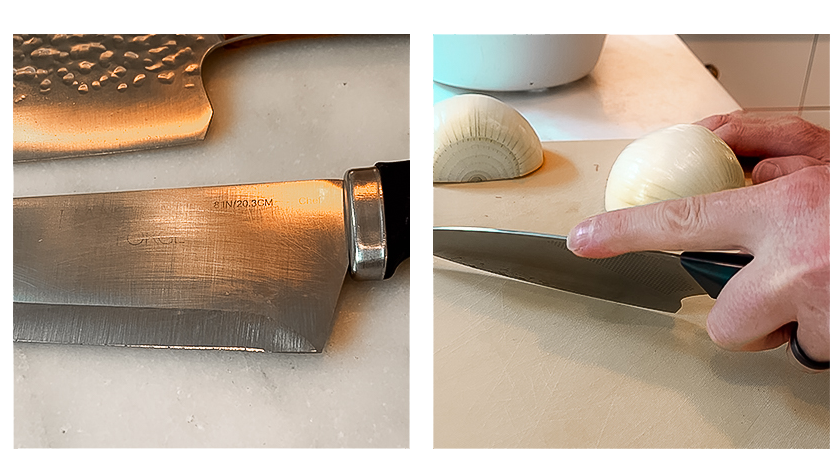

You buy a top-of-the-line, German steel knife (a Nakiri, perhaps). You store it carefully on the magnetic knife rack to protect the edge. You hurl yourself in front of anyone attempting to put it in the dishwasher. You and your knife make quick work of onions, slice through butternut squash like butter, and produce tomato slices so thin and precise that you appear to have used a mandoline. It is the perfect knife.
Six months later, despite all of your tender care, that newish knife won’t cut a tomato, slides off onions and snags on the paper slice test. It never resets to peak sharpness.
Chances are, you haven’t been honing. Enter the honing rod, the tool that’s even more important to keeping your knives sharp than a knife sharpener.
What’s wrong with my knife?
With every impact on the cutting board, even the toughest steel blade will bend slightly and curl over on itself. Think about it: you sharpen a knife to make each side of the blade, the bevel, as thin and fine as possible. Razor thin is just that—microns thick. Regardless of how tough the steel is, that fine leading edge is delicate. With each cut and the impact on the cutting board, the edge begins to curl over onto itself. Once it curls enough, or “rolls,” it essentially turns to mush. This leads to a perception of dullness.
How can I tell that my blade has curled?

A curled blade is nearly imperceptible. But in especially tragic cases, like the one above (left), you’ll notice thin strips of light glinting off the blade. (For illustrative purposes, I went outside and whacked it against a rock. Don’t worry, we fixed it.)
I already have a knife sharpener. What the heck is a honing rod, and why do I need one?
A sharpener will always bring back the edge, yes. But the tradeoff is that you’re shortening the lifespan of your knife, as the sharpener removes steel from the edge. Yes, small amounts, but steel nonetheless.
A honing rod is not a knife sharpener, but a maintenance tool that helps you avoid sharpening by re-straightening the blade. It’s made of very, very hard material, often metal coated in diamond dust or (my favorite) matte-finished ceramic. When the blade’s softer blade meets that super-hard surface, the knife edge is pushed back into place.
How do I use a honing rod?

Feel out the bevels, the angled sides that have been ground down to form the knife’s edge. The knife should slide, easily, up and down the honing rod, which means that you are honing to meet the angle of the bevels (typically between 17 to 20 degrees). If your knife catches, you’re pushing too far in the wrong direction.
Now GENTLY slide the knife—heel to tip—on each side of the blade a few times. Please do not attempt to hone like a movie chef. This is a caress, no more. No force.
Wipe clean before cooking.
How do I know it’s time to use a honing rod?
I try to hone every time I use my knife, but like flossing, I often forget. Aim for a few times a week.
What if my knife has completely rolled?
A honing rod maintains an edge, but it can’t sharpen it. Honing rods can’t work miracles. If a few swipes doesn’t tune it up, it's time to actually sharpen, which removes the curled-over, blunted edge.
When should I not use a honing rod?
Honing rods won’t do anything for a ceramic or serrated blade.
Always be honing
Remember: like death and taxes, all knives dull. Unlike death and taxes, you can prolong the inevitable with a honing rod.
Join the conversation on Facebook, Instagram, TikTok and Pinterest.
And if you're looking for more Milk Street, check out our livestream cooking classes with our favorite chefs, home cooks and friends for global recipes, cooking methods and more.



